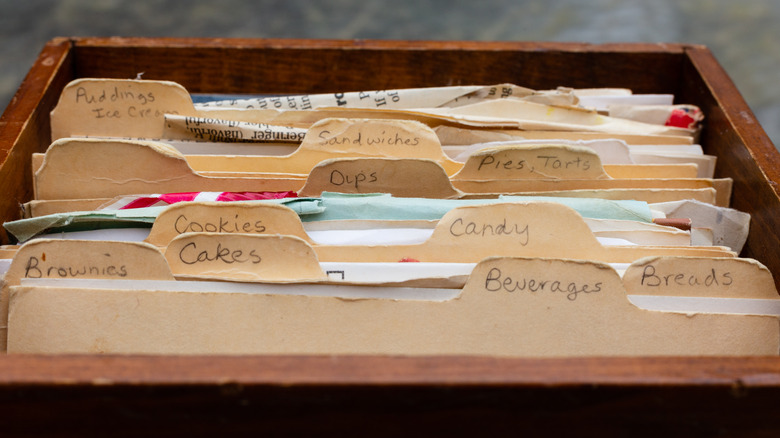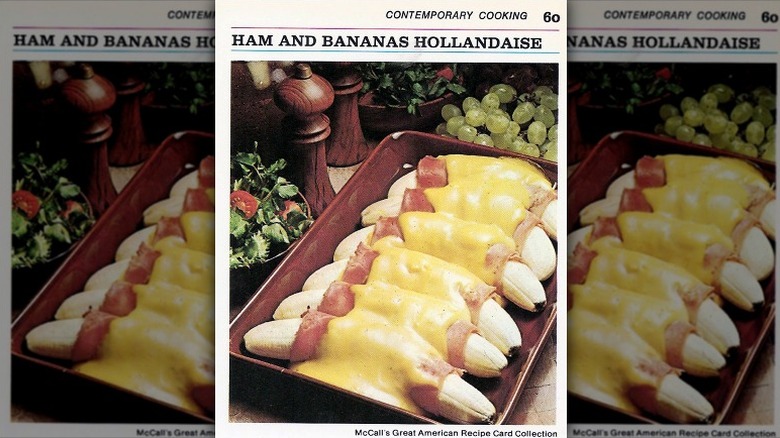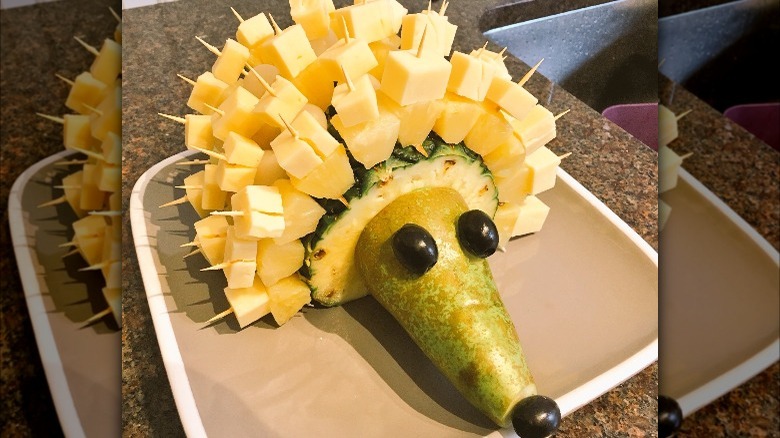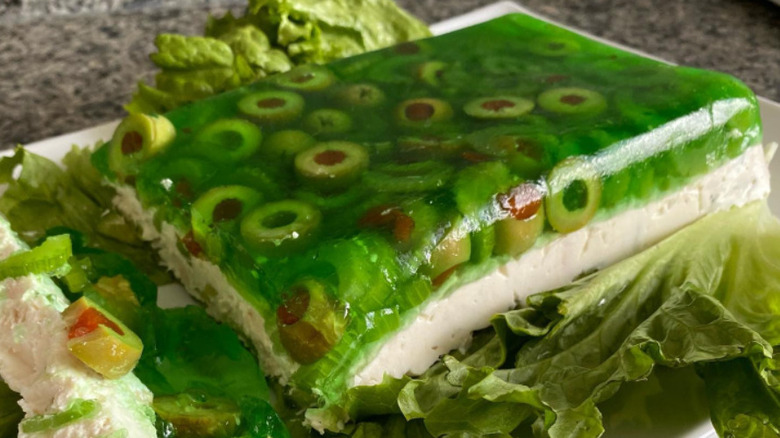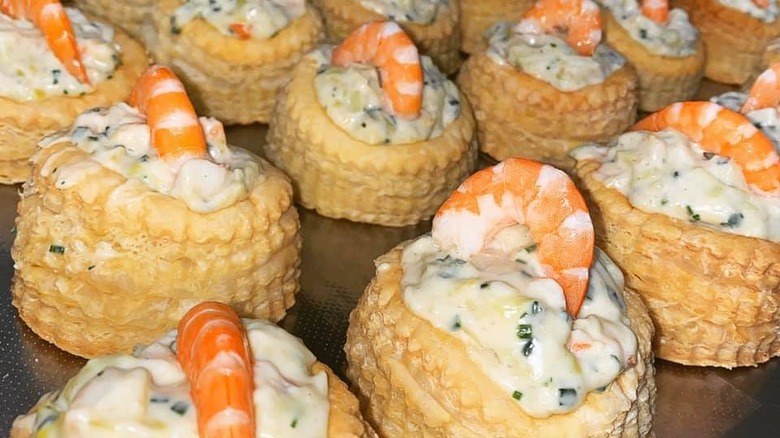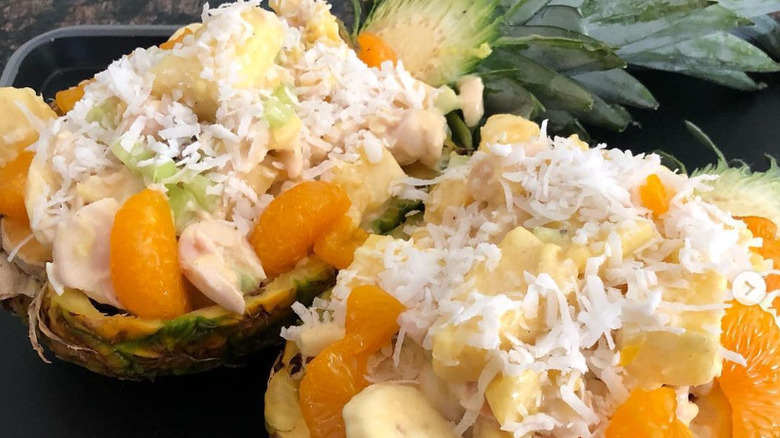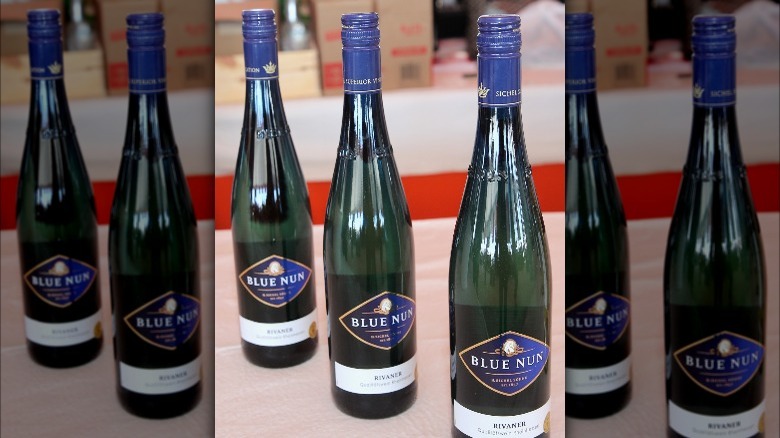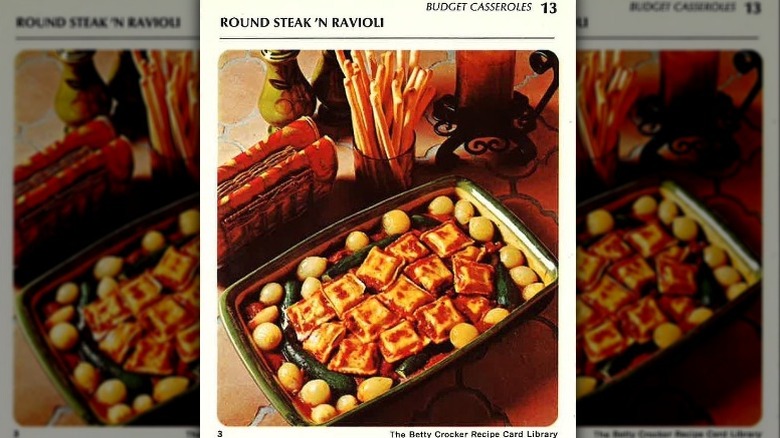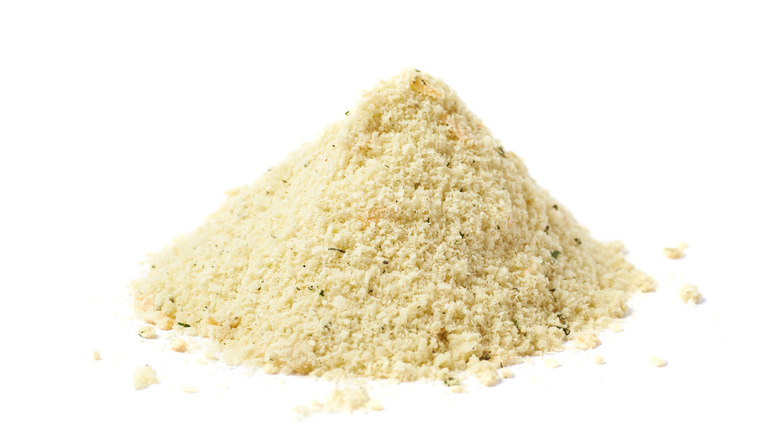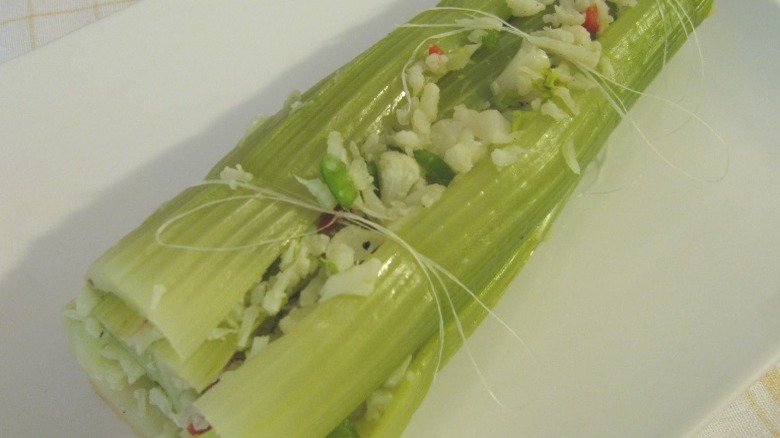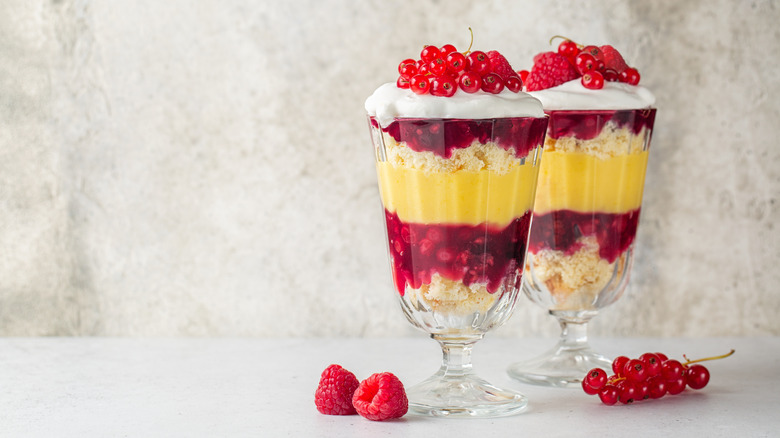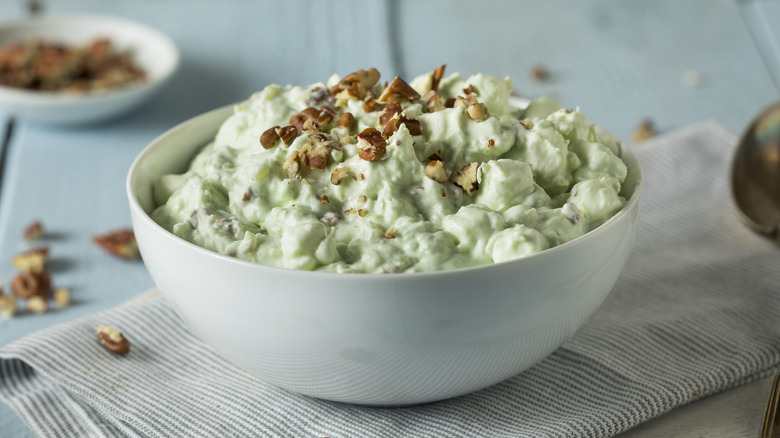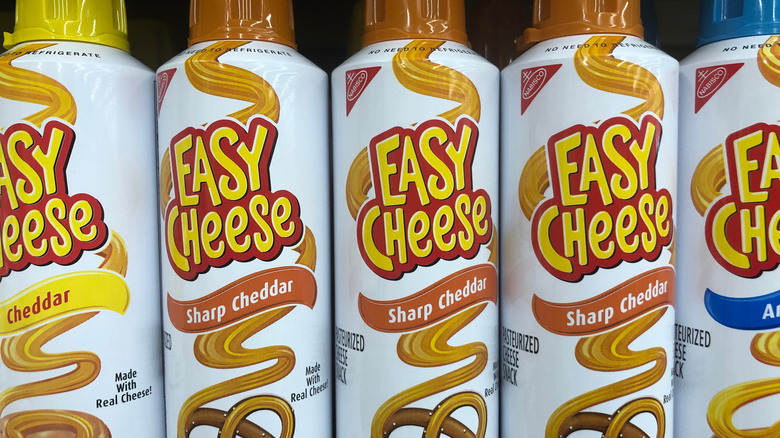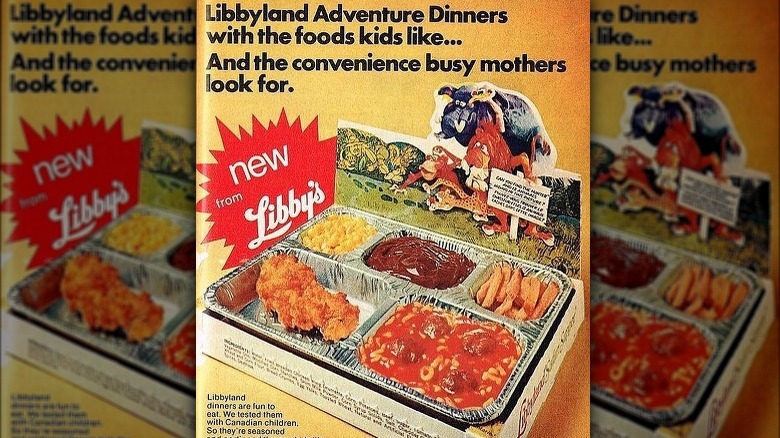Foods From The 1970s That Should Never Come Back
The 1970s was a decade that simultaneously delivered a great number of iconic sociopolitical and cultural moments. From The Watergate scandal that rocked America's political institutions to Francis Ford Coppola's "The Godfather" which changed cinema forever, a lot happened.
Despite a plethora of headline-grabbing exploits and world-changing moments, the '70s will probably always be remembered as a wholly unique time full of peculiarities that many would rather leave in the past. Hair permed to within an inch of its life, bell-bottoms that dragged on the floor, and the ubiquitous '70s disco music are all relics of the past that draw a wry smile from contemporary faces. However, these very same faces are sure to grimace and stifle screams when one facet of '70s culture is mentioned: the food.
The dishes of the '70s have not aged well. Jumbled oddities suspended in garishly colored aspic, a seeming unending fascination with sweet salads, and flavor combinations that boggle the mind all fall far from respectable modern food trends. They are, in fact, so strange that many recipes beg belief. Yet as far-flung as many of these seem, it is vital to remind ourselves that such gastronomic tragedies did occur — if only to remember the quirkiness of the 1970s.
Ham and bananas hollandaise
When America was approaching its 200th year of independence in 1976, a celebratory mood swept across the nation. Special coins were minted to commemorate the historic year, "The American Freedom Train" stuffed full of American-centric artifacts toured the country, and McCall's Magazine joined in on the rising tide of patriotism by releasing a range of recipes to celebrate two centuries worth of American cooking (per Quaint Cooking). The modestly titled "McCall's Great American Recipe Card Collection" was first released in 1973, encompassing 600 recipes spread evenly across 24 sections.
Unfortunately for McCall's and anyone who bought the cards, American classics such as butterscotch pecan pie were thrust up against culinary abominations. The most shocking of which has to be the nauseatingly named ham and bananas hollandaise. The name tells you just about everything you need to know about this dish; bananas are wrapped in ham, baked, and then smothered in ready-made hollandaise sauce before being popped back into the oven. How this dish represents anything good about America and its 200-year-old history is beyond us. Perhaps we will have worked it out by 2076.
Cheese and pineapple sticks
When Hawaii voted for statehood in August 1959, the impact on American culture was immediate and all-encompassing. Tiki culture and aloha shirts rose to prominence as a direct result of television shows such as "Hawaii Five-O," while cheap flights ensured that tourism boomed (per Smithsonian Magazine).
Naturally, this sudden interest in a new exotic pocket of America was also expressed in the national cuisine. Epic, hyperbolic tiki restaurants such as Kahiki Supper Club in Columbus, Ohio, wowed guests with huge totems, flaming cocktails, and artificial rainstorms, The Atlantic describes. The success of such establishments went on to influence American dining culture, with themed restaurants such as the Rainforest Cafe remaining wildly popular within the fifty states.
But perhaps the most infamous upshot of the American Hawaiian culture mashup that occurred in post-war America is the pairing of pineapple and cheese. The endlessly divisive Hawaiian pizza is perhaps the most enduring example of this combination. During the '70s, so great was the Hawaiian fervor that these two ingredients were simply skewered together and poked into a halved, foil-wrapped orange (and other fruit) until something resembling a nightmarish hedgehog emerged (per The Guardian). We cannot move on from this sort of pitiful party food quickly enough, especially if America plans to salvage any kind of respect from the international food community.
Jell-O salad
By the 1970s, Jell-O had long been a stalwart of American cuisine, with sales soaring since the early 1900s (per Serious Eats). This undoubtedly American creation born out of the industrial revolution continued to adapt to a changing market throughout the 20th century.
During its early iterations, Jell-O was marketed as the perfect food for women; it was refined, light, and easy to eat. However, in post-war America, with more women entering the workforce, Jell-O evolved by presenting itself as a quick and easy means for women to fulfill their domestic responsibilities in their ever-busier lives. Ironically, women who served overly convenient instant foods were perceived as lazy and disorganized, Serious Eats explains. To avoid this damaging label, women often placed labor back into the process by combining instant products such as Jell-O with other ingredients like vegetables, meat, and even fish, as The Guardian describes. Thus, the floating monstrosity of Jell-O salad was born.
Jell-O salads began to decline in popularity after the '70s, although many of these half-forgotten dishes are stubbornly revived once a year for Thanksgiving dinners around the country (per The Guardian). In later years Jell-O has looked to pivot away from marketing it as a main meal, a process which began in 1974 with Jigglers, small Jell-O snacks that helped boost the company's overall sales (per What's Cooking America).
Vol-au-vents
The vol-au-vents of 18th-century chef and creator Marie-Antoine Carȇme were revolutionary and substantial pies, built from lightweight puff pastry that lent the dish its name (per The Independent). This esteemed meal can still be found in French bistros and restaurants around the world.
Freshly made vol-au-vents are light, crisp, and packed full of succulent flavor. However, the same could not be said about the versions that became associated with the '70s. Instead, they took the form of individually portioned canapes, bought ready-made from supermarkets and laid out for the all-pervasive '70s party buffets, per Daily Mail. Indeed, such was their popularity at '70s events that they featured in "Abigail's Party" a classic theater production turned film that charted an awkward dinner party organized by an overbearing hostess (via The Guardian).
Deftly labeled "a naff snack" by The Sun, vol-au-vents continue to divide popular opinion. A recent 25% spike in sales reported by high-end British supermarket Waitrose suggests that the buffet staple of yesteryear may be staging a comeback (via Daily Mail). However, Ratula Chakraborty, professor of business management at the University of East Anglia, theorizes that it may be a symptom of the uncertainties created by the Covid-19 pandemic: "When things are constantly changing, like during the pandemic, we crave comfort food and the memories of our childhoods and youth."
Fonduloha
Betty Crocker's 1971 recipe card for fonduloha comes under the subheading American Classics, a perplexing concept for a dish consisting of pineapple served with turkey, celery, curried mayonnaise, banana, mandarin segments, and coconut. However, upon deeper inspection of the divider card from the same collection, it becomes apparent that Betty Crocker's recipes from the '70s were all about celebrating global tastes under the reassuring umbrella of American cuisine. And the fictional Ms. Crocker, a powerful if not unique marketing tool, as per PBS, was absolutely vital to humanizing General Mills' global, industrialized, and processed food.
Despite the occasional fonduloha-like recipe, Betty Crocker's popularity continues to abound in America, and the brand celebrated its 100th birthday in October 2021. This prolonged success has been sustained by focusing on the original goal of the brand: to make cooking easy for all. Betty Crocker continues to provide cooking tips online to troubleshoot common problems for home cooks. Thankfully, as of yet, none have focused on fonduloha, hopefully meaning this ghastly invention never appears in kitchens again.
Blue Nun
It is rare that one product can single-handedly damage a whole export sector, yet it is not unheard of. Per The Guardian, the semi-sweet wine Blue Nun is a prime example. Blue Nun soared to popularity in both the United Kingdom and America during the post-war years by marketing itself as a wine for all foods and occasions.
It quickly became the savior of wine novices, freeing them from the potential embarrassment of poor wine and food pairings (per The Guardian). As a result, this simple wine proved extremely popular during the '70s and early '80s, with annual sales reaching two million cases globally (per The Times). Sales also increased by 500% thanks to an iconic American advertisement by the late comedian couple Jerry Stiller and Anne Meara (per Chicago Tribune).
Unfortunately, the wild success of Blue Nun led many to believe that the only wine Germany offered was basic and sweet, The Guardian explains. As tastes evolved, many people turned their back not only on Blue Nun but on German wine in general. However, thanks to the tireless work of wine aficionados like Eric Asimov at The New York Times, there are hopes that a range of German wines can once again be appreciated across America.
Round steak 'n ravioli
Round steak 'n ravioli is another corker from Betty Crocker's 1971 Recipe Card Library. It lies under the subheading of Budget Casseroles, meant to assist housewives in serving a filling meal without spending a fortune. Despite the frugal claims, round steak 'n ravioli is still presented as a plentiful and enjoyable dish; one to share with family members throughout the week.
An emphasis on bountiful larders and copious amounts of food is a common theme throughout Betty Crocker's recipe card collection. As reported by The New York Times, prominent food historians have suggested that this focus on abundance, which was reaching dizzying heights during the 1970s, was a direct response to the frugality of communism and formed part of the Cold War raging during this period.
Round steak 'n ravioli probably won't become America's national dish anytime soon though. Unless you're eager to dig into meat mixed with canned ravioli, whole unpeeled zucchinis, and canned spaghetti sauce.
Smash
Driven by scientific advancement, industrialization, and futuristic obsessions, many of the food products available during the 1970s were almost unrecognizable for those who grew up in the pre-war years. One such product was Smash, freeze-dried potato granules that could be mixed with boiling water to make instant mashed potatoes, The Guardian describes.
As is so often the case, marketing was the only element that set Smash apart from its competitors. In the UK, a wildly successful advertisement showed a group of confused martians watching humans make mashed potatoes using the traditional method (via BBC). However, health concerns over eating instant mashed potatoes and changing consumer behaviors caused Smash to fall out of favor as the decade passed.
Appetites for instant mashed potatoes seem not to have wavered on this side of the Atlantic. Per Statista, in 2020, 85.33 million Americans consumed packaged instant mashed potatoes, suggesting there remains a huge market for conveniently prepared tubers.
Chilled celery log
Trying to lose weight is rarely an enjoyable process. It can involve arduous workouts, strict scheduling, and difficult choices about what food to eat. Because of these challenges, many people turn to groups for guidance throughout their weight loss process. Weight Watchers, perhaps the best known of all weight loss groups, began its official life in New York in 1963. It has since spread rapidly across the globe, amassing one million members in the first five years. And while Weight Watchers continues to help millions of people lose weight, the recipes they provided in the past have not always aged so well.
To put it plainly, the 1974 Weight Watchers Recipe Cards are home to some of the '70s worst dishes, exemplified by the infamous chilled celery log. This aptly named dish consists of roasted and mashed cauliflower stuffed inside a tube made of boiled celery. Fortunately, Weight Watchers has continued to evolve with the times and its recipes now include much more palatable dishes. Losing a few pounds doesn't need to be as torturous for your taste buds as it once was.
Instant trifle
Trifle, a highly decorated and extremely customizable British dessert, was not an immediate candidate for the ready-to-make mania that swept over the Western world during the 1970s. The layered dessert consists of sponge cake, fruit or jam, custard, and whipped cream, per Taste Atlas. This combination of textures and ingredients is a daunting task to recreate from a dehydrated powder. Yet there were plenty of manufacturers who took on the challenge with glee.
Among them was Bird's, an instant custard manufacturer owned by ready-to-make behemoth Premier Foods. After experiencing roaring success with its original egg-free custard which was first made by chemist Alfie Bird in 1837 (per Birmingham Mail), Bird's eventually produced an instant trifle. Despite its gloopy nature and high levels of preservatives, the packaged dessert proved wildly popular in the '70s.
Trifle is clearly comforting in nature but it remains a product best left in the past. As any trifle aficionado will tell you, the dish is all about contrasting textures and a beautiful presentation – two elements that instant trifle can never provide.
Watergate salad
Watergate salad is an interesting name for a variety of reasons. For starters, it contains no leafy greens, vegetables, or dressings that you would usually associate with a salad, although to its credit, it is green in color. That is because Watergate salad, born out of the gelatin craze that came during the 20th century, contains pistachio pudding mix, canned pineapple, whipped cream, and chopped nuts (per My Recipes).
It remains the only dessert salad that shares its name with one of the most prominent government scandals of the 20th century. However, it would be remiss to say the salad was named after the Watergate scandal. Instead, Atlas Obscura indicates that the beloved green fluff was named after the Watergate cake with which it shares a striking resemblance. Yet the association between the dessert salad and the scandal has only strengthened throughout the past decades.
The dessert salad's drop in popularity was much more gradual than that of President Nixon's and came about as a result of the dated methods and ingredients used to make it, NPR explains. And while there are many who mourn the loss of another American sweet salad, we can know for sure that those with concerns about sugar intake – as well as some very prominent members of political society — would be glad to never see it served again.
Snack Mate
The 1970s wasn't a great culinary decade for many nations, however, some slipped to deeper depths than others. Unfortunately, one of the countries that hit rock bottom was the U.S. Still drunk from the 1969 moon landings, the American population fantasized about further space travel; anything that resembled a high-tech futuristic life was consequently highly prized.
In the futuristic thralls of the 1970s, Americans paid little heed to traditions such as the ancient practice of cheesemaking. It's fair to say they deeply offended cheesemongers everywhere with the abominations created during this time. A prime example was Snack Mate, a processed cheese spread that could be sprayed out of a bottle in a thick stream (per Paste Magazine).
Marketed as a convenient alternative to traditional cheese, Snack Mate promised — as many products did at the time — to provide an elegant solution for time-stricken hostesses looking to impress friends and family (per Snack Stack). After releasing seven different flavors including pizza (and even more inexplicably, shrimp cocktail), Snack Mate was rebranded as Easy Cheese. To America's eternal shame, the product is still sold by one of the world's largest snack companies Mondelez International.
Libbyland dinners
It's clear that health wasn't often at the forefront of anyone's mind during the 1970s. The success of Libbyland dinners would suggest that even parents were not excluded from this decade-long oversight. Equally celebrated and abhorred as being the first TV dinners made specifically for children, the themed frozen food trays included games, stories, and "magic milk crystals" which turned normal milk into an extremely sweet drink (per EatThis).
With meals like Safari Supper and Pirate Picnic, you can bet that kids loved the mixed assortment of hot dogs, tater tots, hamburgers, and pudding that could be found in the average tray (per Long Island 70s Kid). Filmmaker Harrison Smith reminisces on how the TV dinners formed a happy part of his childhood memories, noting that they were easy to enjoy while watching horror movies (via Dread Central). Definitely nutritionally questionable, Libbyland dinners nevertheless managed to make a large impression on children during their time on shelves.
